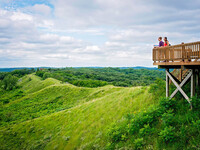The DNR's Wildlife Bureau manages over 410,000 acres that are available for public recreational use every day of the year. All of these areas are managed with revenues from the sale of hunting, fishing, and trapping licenses that are purchased by resident and non-residents. These state revenues are supplemented with Federal Sport Fish & Wildlife Restoration funding from the U.S. Fish & Wildlife Service. This federal money is comprised of an excise tax on hunting and fishing equipment collected by the federal government and then distributed back to state fish and wildlife agencies. As such, wildlife management areas are funded almost solely by hunters, fishers, and trappers.
The funding sources used to manage these areas ensure that they are managed to provide habitat for Iowa's native wildlife species and those species that migrate through our state. Developing and restoring wildlife habitat for wildlife species to have a safe place to breed, rest, and feed is the primary management objective. Wildlife dependent recreational activities are allowed to enable residents and non-residents to enjoy these wildlife species.
Only basic public use facilities such as parking lots and boat ramps are provided. Portions of these areas may be designated as refuge and restrictions are placed on certain uses that may interfere with management goals and objectives.
Before visiting a public wildlife area, please check out Chapter 51 : Wildlife Management Areas and Chapter 52 : Wildlife Refuges, of the Iowa Administrative Code to ensure that you have a safe and successful experience on these areas.
Organized events to be held at wildlife management areas must be approved by the DNR, and must be applied for at least 30 days before the scheduled date of the event. All applications must be filed with the DNR using the Special Events web-based applications found at https://programs.iowadnr.gov/specialevents/.
Hunting Atlas
Interactive map of Iowa's public hunting lands. View larger map
